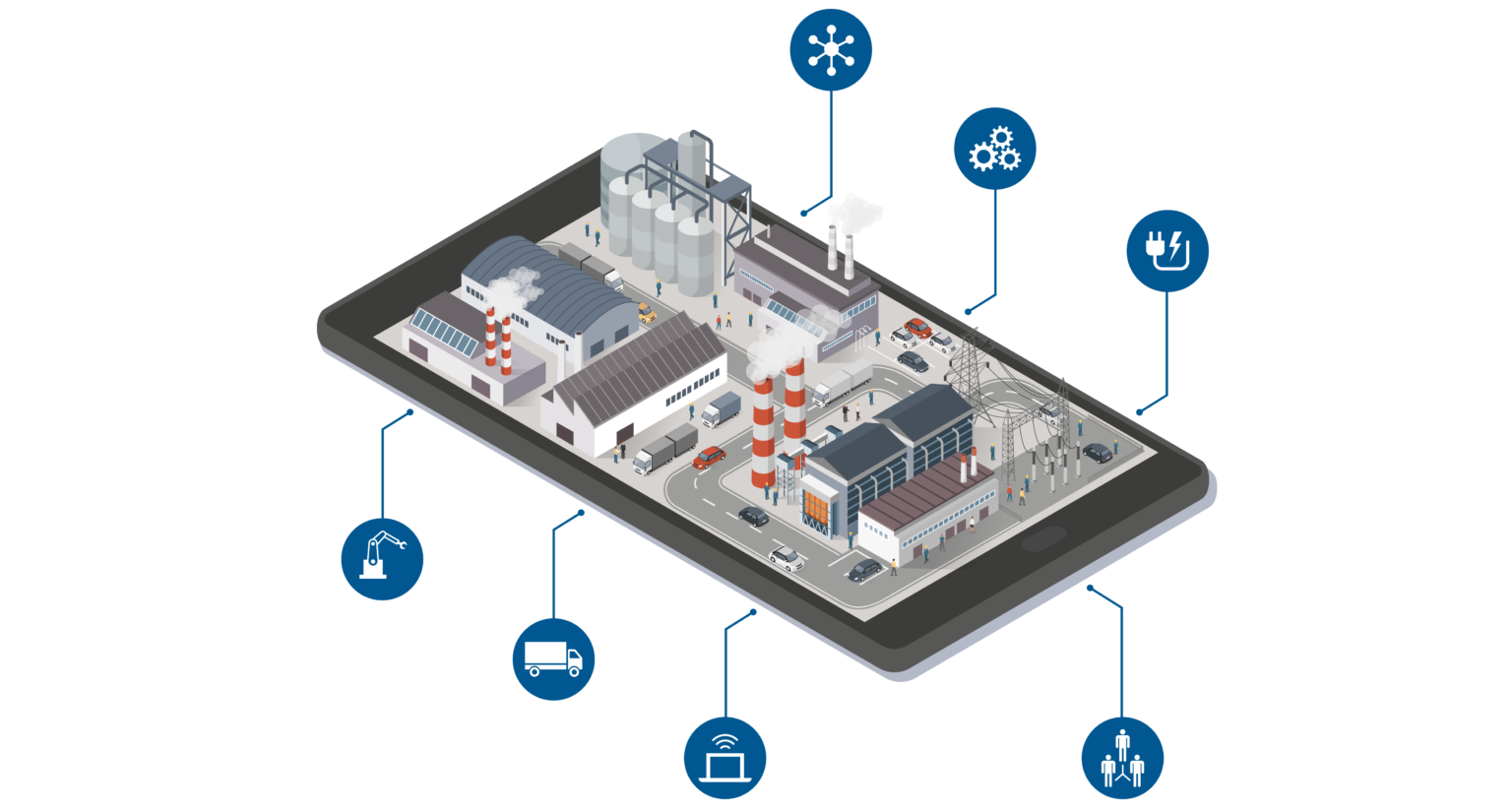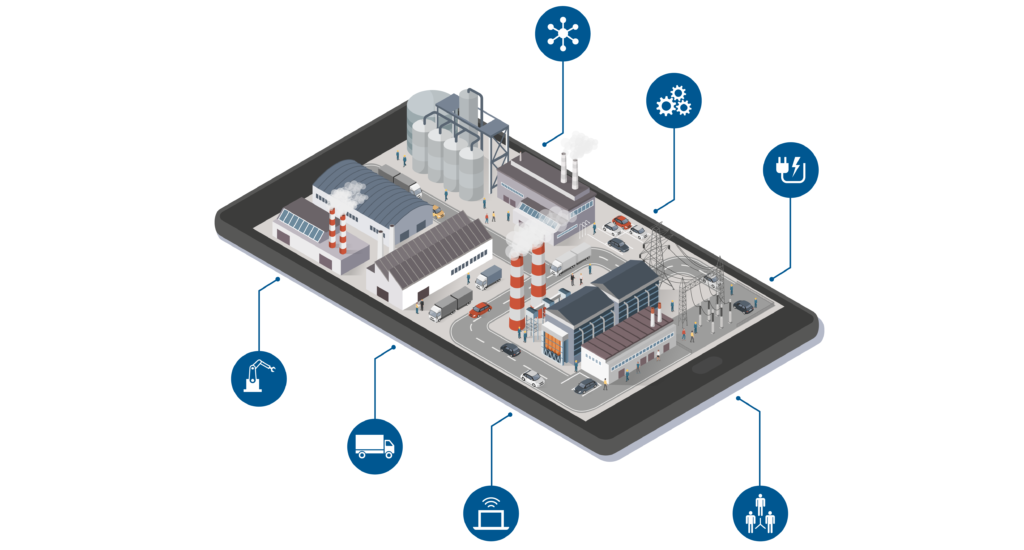What is digital transformation?
Digital transformation as a component of digitalization
Due to the continuous and rapid change in society, terms such as digital transformation and Digitalization frequently crop up. But what do they mean exactly? Especially in the context of introducing new digital technologies, which open many new doors for companies’ business models, these terms are constantly popping up. These modern technologies enable transformation of old and rigid processes from a current state (ACTUAL) to the desired target state (TARGET).
In the following article, you will find everything you need to know about digital transformation, and how your company can implement it and profit from it.
Definition
Digital Transformation is a continuous process for the further development of digital technologies, which in turn have a lasting impact on the economy and society. Digital technologies such as social media and more specific areas such as the Internet of Things (IoT), Big Data and cloud services are part of digital transformation. Consequently, digital transformation is influencing both technological processes and everyday life.
Difference to digitalization
Digitalization and digital transformation are often used in the same context because the distinction is blurred. Digitalization merely describes the process of digitizing analog media. However, it is also used as a synonym for automation now, although this does not match the original definition.
Digital Transformation goes a step further here, identifying digital solutions to existing and the latest problems. Not only individual analog processes are then digitized, but complete business processes. Such solutions become possible through new technical methods and are not limited to any business unit or process.
Necessity of transformation
Due to the constantly changing general conditions, the economic pressure on traditional business models is increasing. That is noticeable through the stagnation of growth. As a result, companies cannot operate at their usual level of profitability. This pressure also affects executives. According to a McKinsey study, only a minor proportion believe their business model will withstand the digital transformation.
That is why the successful implementation of digital transformation is indispensable and essential for the company’s continued existence.
Benefits of digital transformation
One advantage is immediate decision-making through all-encompassing insights from a lush data pool. The use of modern ERP systems and advanced analytics enables companies to view real-time data to evaluate performance and ROI. All this real-time data gets delivered through a functional IoT network. Data, machine logs and performance reports are continuously transmitted. Analytics are available to make efficient and productive use of these. The insights gained enable higher productive and efficient processes.
A fundamental advantage of a successful digital transformation is the reduction in costs and increase in productivity.
The three categories of digital transformation
Business process transformation
Business goals, competitive situations, and changing customer demands require core processes and workflows to respond quickly. These changes and adjustments to already existing processes describe this category. Digital transformation is part of the generic term business transformation. That refers to the fundamental technological framework to enable process changes in the first place. This category is of particular importance because improving workflow management has a positive impact on overall business processes.
Business model transformation
This category focuses on the digital transformation of fundamental components of value creation in a specific industry. Simply put, this means a change in traditional business models.
Organizational and cultural transformation
In a digital transformation, the culture and values of an organization are of crucial importance, as these must never get ignored. Productivity, motivation, and well-being can deteriorate within the organization, and a loss of trust in the culture can occur. A hesitant or pessimistic attitude towards digital technologies can have a counterproductive effect. Therefore, it is recommendable to enable open communication and collaboration within the organization .
What enables transformation?
Infrastructure
The foundation for digital applications is digital infrastructure. The digital infrastructure consists of various segments that work together. On the one hand, many access and end devices are required, such as classic desktop computers, but smartphones and tablets are also part of this. In addition, there is an ever-increasing number of embedded systems in devices, such as machines. Network structures (wireless or wired) and the associated protocols complete the infrastructure. That enables data to be exchanged between digital applications and to network them. Thus, a functioning digital infrastructure is made possible. Learn more about the basics of machine data acquisition here.
Applications
Digital applications require this digital infrastructure. They are programs that use the networked infrastructure to realize certain functions and services. In the past, such functions used to be analog. An example of a digital application is middleware. This application ensures that all systems within a company communicate with each other and exchange data. That makes it possible, among other things, to record and document of all activities of machines within a digital infrastructure. Previously, this documentation had to be done by hand.
The four factors of success
Changeability
That involves checking what change competence is available in the company and what the readiness of the employees for an adaptation is. For a successful transformation, the entire workforce must have a suitable mindset. To achieve this, all areas of the company must pull together.
Innovative energy
Implementing digital transformation requires innovations. That is why the promotion and targeted advancement of innovative ideas is essential. Ensuring this innovative structure can only be done by being open to change within the organization.
Technical and methodological competence
Digital transformation also brings new tasks and roles for employees. Integrating these employees into continuous learning processes is essential to prevent them from being overburdened. Ultimately, they are responsible for the actual implementation of digital transformation in many areas.
Data competence
Digital transformation is advancing steadily. Therefore, keeping a constant eye on the market and new developments is essential. Data is indispensable to make this possible. The correct data must be collected, analyzed and evaluated to achieve this.
Digital transformation in industry
Digital transformation can take hold in many areas – including industry. With digital technologies components can communicate independently with production plants or arrange for repairs to the plant itself. When people, machines and industrial processes are intelligently networked or completely new, data-driven business models emerge, we talk about Industry 4.0 . Modern information and communication technology become interwoven in this process.
As a result, rigid and firmly defined value chains are more flexible and dynamic. In this way intelligent IoT networks can be created, which makes data-driven production possible.
In order to allow systems to communicate with each other and to set up an IoT network, the use of middleware unverzichtbar. Diese digitale Anwendung ermöglicht erst die Kommunikation unterschiedlicher Systeme. Eine aus der Praxis bewährte Middleware ist zum Beispiel der OPC Router.
When it comes to processing large volumes of data, edge computing and cloud computing technologies play an important role. There are a wide variety of solutions in this area. One example is manubes, a cloud platform for digital production management that relies on edge technology for system connectivity.


